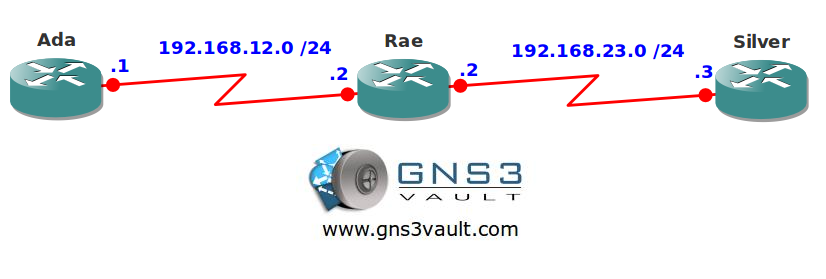Scenario:
Ada and Silver are using the network for a range of applications like FTP, HTTP, TELNET and more. Recently there have been some complaints about slow network performance and it’s up to you to make sure each application gets a fair share of the bandwidth.
Goal:
- All IP addresses have been preconfigured for you.
- EIGRP has been configured for full connectivity.
- Configure the S0/1 interface of router Rae with a bandwidth of 64kbps.
- Configure WFQ on the S0/1 interface of router Rae. The output hold-queue size should be 128, length of 16 for congestive discard threshold, a maximum of 128 conversations and 4 queues for RSVP.
- Configure the hardware queue on router Rae so WFQ will be activated as soon as possible.
IOS:
c3640-jk9s-mz.124-16.bin
Topology:

Video Solution:
Configuration Files
You need to register to download the GNS3 topology file. (Registration is free!)Once you are logged in you will find the configuration files right here.

Do you want your CCNA or CCNP Certificate?
The How to Master series helps you to understand complex topics like spanning-tree, VLANs, trunks, OSPF, EIGRP, BGP and more.
Written by René Molenaar - CCIE #41726


enjoyed this one, off to blog
Glad you like it Brian.
QOS is a bit hard to test on GNS3 (no performance) but IP SLA is nice to test if you want.
You can also try to use a ping with big packets to “congest” a link.
Hello Rene,
Wanted to know why do you use x and y values in the .net file and apart from this i see lot of notes configured in the .net file wonder what they are used for? Thanks
[[ROUTER Ada]]
model = 3640
console = 2010
cnfg = configs/Ada.cfg
slot0 = NM-4T
s0/0 = Rae s0/0
x = -425.0
y = -113.0
[[NOTE 1]]
text = .3
x = 54.4472221514
y = -115.334523779
color = “#0000ff”
Not sure why it shows the “X” and “Y” at the router section, has to do with the position of the router in the picture.
The “note” stuff is because I add text to the GNS3 topology. The one you pasted has the text “.3” which is what I placed at the interface for router Silver.
Thanks Rene appreciate your help..
Hello,
There is one question in this scenario
•Configure the hardware queue on router Rae so WFQ will be activated as soon as possible.
Could you please provide the answer for this one.
Thanks
Hi Vinod,
Good question! This is one of those ‘little things’ I encountered while studying for my CCIE.
Qos on routers is a software queue, the hardware queue is always FIFO (first in first out). We can reduce the size of the hardware queue so packets will be shorter in this FIFO. You can use the “hold-queue” command to change this.
Rene
one question please what is the diffrence between hold queue and tx ring command
Without queueing configured the router does FIFO (First In First Out) by default (software). The hold-queue command configures the size of your FIFO.
The tx-ring command configures your hardware-queue.
Hi Author !
you configured right, but i thinks you should verify configuration. In GNS 3 some feature of QoS you can not verify and test exactly.
how to purchase video for QOS.
please guide me.
anishkumar573@gmail.com
thanks
anish kumar
Hi Rene, The last step of your lab could not be enabled on my GN3 servers I wonder why ? Please advise Cheers !!!!